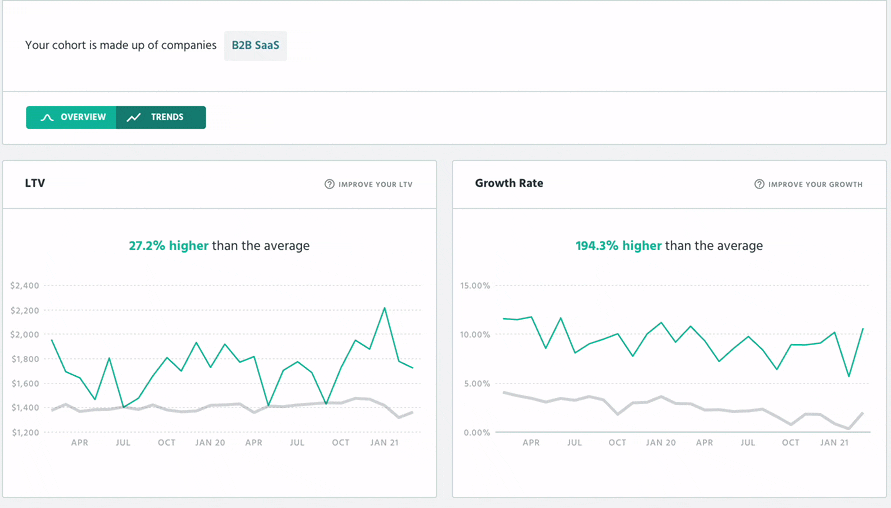Whether you’re a new company or a growing business, you’ll need to understand your unit economics before taking your business to the next level.
Unit economics are often considered one of the foundational building blocks of business, but many business owners don't even know what the term means. In this post, we'll talk about what unit economics are and tell you how you can use this knowledge to expand your understanding of your business. This newfound way to look at your business will allow you to make more informed decisions and increase profitability.

What are unit economics?
Unit economics are the direct revenues and costs of a particular business measured on a per-unit basis, where a unit can be any quantifiable item that brings value to the business. Calculating unit economics makes it easier to forecast things such as break-even points and gross margins. Most businesses are probably, at least on some level, using unit economics calculations even if they are not familiar with the term. But fully taking advantage of your unit economics requires a little more commitment and understanding.
13 unit economic metrics
Before we can tell you how to calculate your unit economics, you need to understand the metrics that go into the calculation. There are many ways to measure the success of a business and to predict its financial stability. Each of those has its own set of key performance indicators that need to be tracked.
Looking to supercharge your growth? Watch our webinar on revenue metrics in 2023
Basic unit economics needs just two: LTV and CAC. But the more accurate formulas we'll discuss later rely on much more in-depth metrics. This section will cover all you need to know. The abbreviations given will be used when describing the various unit economics formulas in the next section.
1. Lifetime value (LTV)
Customer lifetime value is the average amount of money that you earn per customer over the lifetime of their relationship with you. In SaaS, this is the amount of money you make from the time they sign up, to the time they cancel and don't return. Calculating LTV accurately can tell you a lot about your business.
2. Customer acquisition cost (CAC)
The total amount of money you spend on sales and marketing to acquire one customer. If you spend too little, you don't get new customers. If you spend too much, you don't get profit. The right amount to spend is very directly tied to your LTV, so calculating and understanding your CAC is extremely important.
3. Churn rate
Churn rate is the percentage of your customers that cancel their subscription during a given period.
4. Retention rate (R)
Retention rate is the opposite of churn. It's the percentage of customers that remain subscribed during a given period.
5. Average customer lifetime (ACL)
This is the average amount of time a customer stays subscribed before they churn. It is a key component in calculating their lifetime value.
6. Number of customers (C)
This is the total number of customers subscribed to your service during the period in question.
7. Number of transactions (T)
Not every customer is billed at the same frequency. This metric covers the actual number of transactions that have been made during the period and may not equal the number of customers.
8. Total revenue (TR)
This is the total amount of money you've made from your customers over the course of the period.
9. Gross profit (GP)
This is your total revenue minus your cost of sales.
10. Average order value (AOV)
This is simply total revenue divided by the number of orders.
11. Average gross margin (AGM)
This is your gross profit divided by your total revenue.
12. Gross margin per customer lifespan (GML)
This is similar to your raw LTV rate, except it only takes the margin into account, rather than total revenue.
13. Discount rate (D)
Your discount rate is the rate of your return on investment.
How do you calculate unit economics?
The easiest way to calculate the unit economics for your company is to find the revenue per customer and divide it by the costs associated with that customer. How you derive those values, and what qualifies as a unit, varies depending on the particular business model. For most SaaS businesses, the basic unit economics calculation boils down to LTV divided by CAC. Later in the post, we'll discuss ways to take more information into account in order to make a more accurate prediction.
Simply using your LTV metric, however, doesn't always tell the whole picture. It's looking at the past to try to predict the future. Instead, you can use additional metrics for a more accurate prediction. There are two popular ways to accomplish this. For well-established businesses, predictive LTV is a good choice. For newer businesses, or newer product launches where revenue hasn't quite stabilized yet, using a flexible LTV calculation makes more sense. Whichever you use, divide the result by CAC just as you did above for the simplified version to get the unit economics.
Predictive LTV
This formula tries to take into account how customer preferences change over time. It can help you avoid a sudden and unexpected drop in sales. Using the abbreviations from the section detailing the metrics, the formula for calculating predictive LTV is:
Predictive LTV formula: (T x AOV x AGM x ACL) / C
Flexible LTV
Predictive LTV is good when revenue is rather stable. When you are just starting out with a new business or a new product, this isn't always the case. Flexible LTV is a metric that will take retention and discount rates into account to provide more accurate results during those times. The formula is:
Flexible LTV formula: GML x (R / 1 + D - R)
What exactly is a 'unit'?
Let's take a closer look at what we mean when we talk about units. A unit will always, on some level, represent a customer. How exactly that is defined may vary though. What ultimately matters is that you are consistent in your own usage of the term. Other than that, as long as you understand what units are and aren't measuring some irrelevant metric, your calculations will be beneficial. Let's look at how you may define a unit in SaaS.
Units as customers
If you have a large business make a purchase with your company, they are likely to purchase several subscriptions. They have a large number of employees who need to use your software. So, is the business a unit, or are each of the individual subscriptions? With the units-as-customers model, the business counts as one unit.
Units as products sold
For the units-as-products-sold model, the above scenario flips. For a SaaS business, that would mean each subscription is counted as one unit. For SaaS, this is less common. For physical products — where there are production costs per item to account for — units as products sold is more standard.
If you're still wondering whether it makes sense to count the multiple accounts of your business clients as one unit or several, consider the effort put into acquiring those accounts. What unit economics is tracking is how much it costs you to acquire a customer compared to what they bring in. If your business accounts require active effort on the part of your sales staff to add additional users to their accounts, then those are expenses that should be counted. On the other hand, if the business simply adds and removes users as their need grows, then your CAC is the same and those accounts should be counted as a single unit.
Why SaaS businesses should track unit economics
What unit economics is tracking is whether or not the lifetime value of a single customer exceeds the cost of acquiring that customer. That alone is fantastic information. If you're spending more to get a customer than you'll get out of them, you won't be in business very long. Let's look at some less obvious benefits of tracking unit economics:
Measuring early success
In the early stages of a business, unit economics are an even more important factor in determining how much you can spend on acquisition and how much you can expect to get in return. They are a great predictor of the long-term financial health of your business model.
Evaluating changes
Unit economics is a useful measuring stick for changes you may make to your marketing strategy or budget, pricing model, or any other changes that may affect sales or churn rates. Simply knowing whether sales go up isn't enough. If the LTV to CAC ratio changes unfavorably, you might want to rethink the decision.
Financial planning
Your business benefits when you can plan its growth. To do that, you need to have some idea of how much capital you will have in the future. Combing unit economics with your acquisition rate will give you an idea of how much your company will be bringing in and aid with financial planning.
Best practices to keeping your unit accurate
It doesn't matter how powerful a metric is as an indicator of the value you're using is improperly calculated or out of date and no longer applicable. Because you'll be using unit economics to drive important business decisions, some of which may have severe implications on profitability, you want to keep the value you use as accurate as possible. Aside from doing the rather simple math equation correctly, having an accurate unit economics calculation means recalculating it whenever the need arises. Let's take a look at some examples of when that might happen.
Recalculate your CAC
Your LTV isn't easy to mess up the calculation for. Tools like our free ProfitWell Metrics make it easy to keep track of KPIs like that one.

CAC, however, relies on you maintaining an accurate accounting of your sales and marketing costs. If you decide to increase your ad budget one month, you can't forget the effect that is going to have on your CAC.
Recalculate whenever pricing changes
It may be easy to keep track of your LTV, but if you forget to roll any updates to it into your unit economics calculations, then your LTV:CAC ratio will be incorrect and any insights gleaned from it will be based on faulty information. Whenever you change your pricing, there's going to be movement in your LTV. Our Price Intelligently service can help ensure that LTV movement from pricing changes goes in a direction favorable to you.
Recalculate whenever costs change
Similar to LTV above, having an accurate CAC doesn't mean anything if you don't also roll that into your LTV:CAC ratio calculation. Whenever something causes your CAC value to change, make it a habit to also immediately calculate your new unit economics so you are always using the most up-to-date values.
Unit economics FAQs
Because this is an important, yet possibly confusing topic, it is worth going over some of the common questions people have about unit economics. Hopefully, you'll come away from this post feeling that you have a firm understanding of how understanding your unit economics can help your business.
Are unit economics important in business?
Yes. Understanding exactly what it costs you to bring in a customer, and exactly how much money you can expect from that customer is vital to properly budgeting. If you aren't maximizing your LTV:CAC ratio and the benefits it brings, then you aren't maximizing your growth, profitability, and sustainability. It's one of the most important metrics your business can work to improve.
How do you calculate the economics of one unit?
The first step to calculating your unit economics is to decide what one unit will represent. For a SaaS business, it makes sense to count a company, and all of the subscriptions they have, as one unit. This is even more true when you are a B2B business. You can, however, count individual subscriptions as a unit if that makes sense for your company. Once you have your unit, calculate how much the lifetime revenue for that unit is, and divide it by your CAC to get the basic economics of that unit. It is a better practice, however, to use the predictive LTV or flexible LTV values, given above, when calculating your unit economics.
How do you improve unit economics?
There are two ways to improve unit economics. The first is to spend less on sales and marketing. This is not the best way, as it will slow growth. Sometimes, you have to reign in spending though, and if the LTV:CAC ratio is too out of balance, cutting the budget makes sense.
The better way is to improve your LTV. ProfitWell can help you can do that by optimizing your pricing, as well as help you take the right steps toward reducing churn and increasing the amount of time a customer stays with you.




